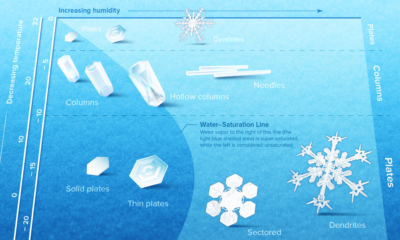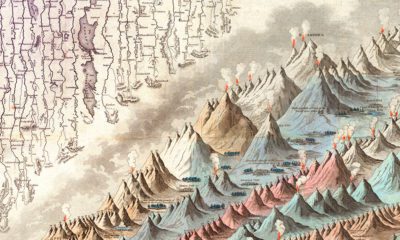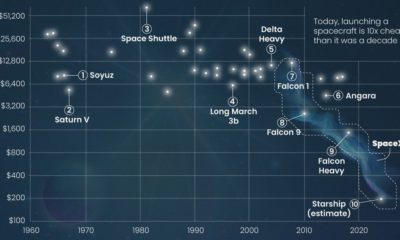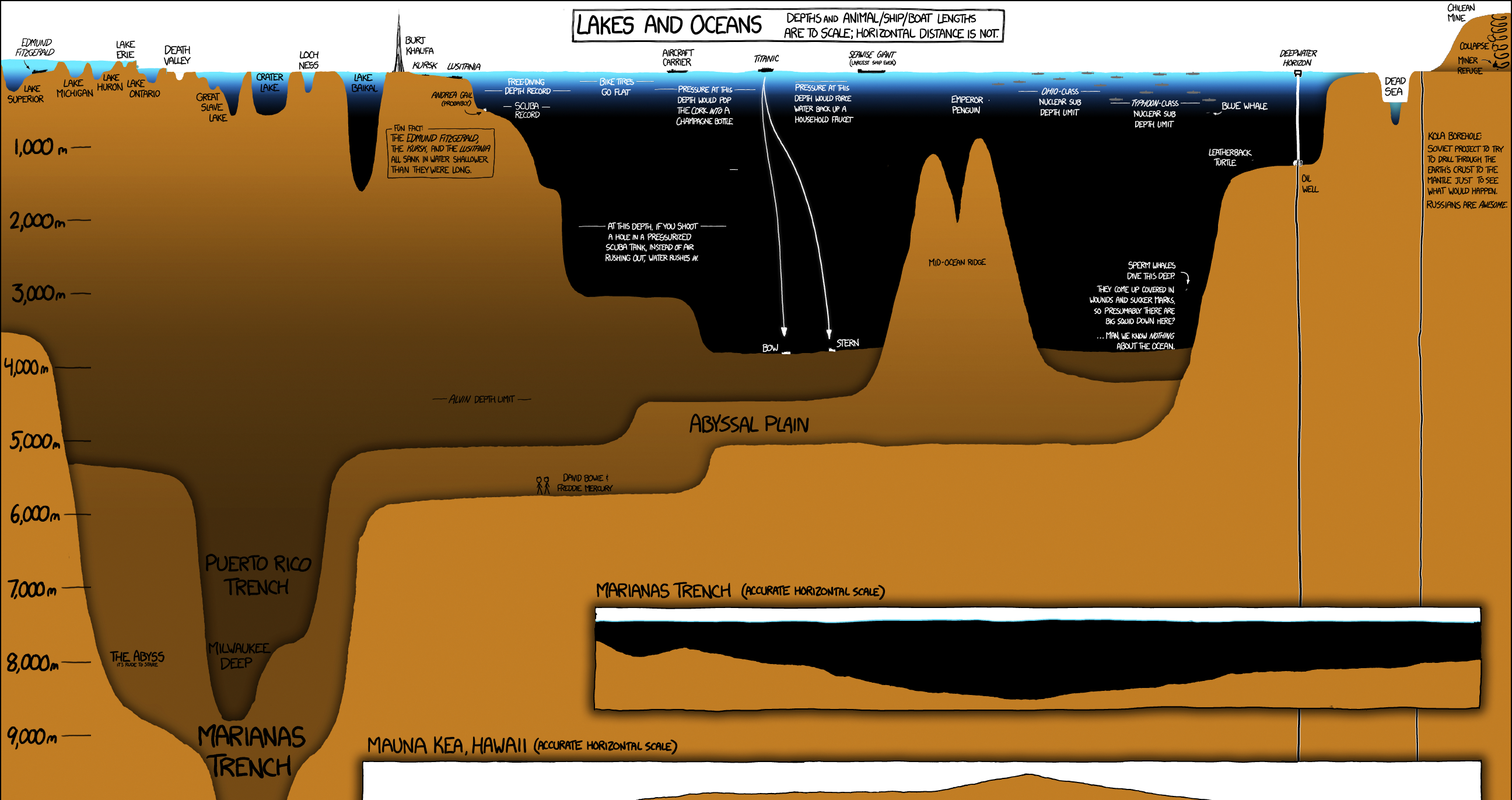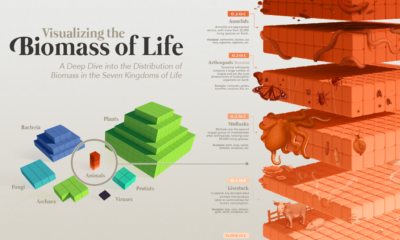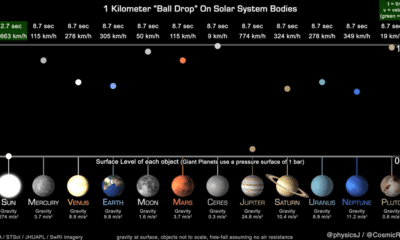But while Earth’s atmosphere stretches for about 10,000 km (6,200 miles) above the planet’s surface, only a thin layer is actually habitable. This graphic, inspired by Andrew Winter, shows just how small Earth’s “habitable zone” is, using the state of Florida as a point of reference.
Earth’s Like an Onion: It Has Layers
Our planet’s atmosphere is made up of a unique cocktail of gases—roughly 78% nitrogen and 21% oxygen, with trace amounts of water, argon, carbon dioxide, and other gases. It’s separated into five different layers:
Exosphere: The uppermost layer of our atmosphere that melds into outer space. Thermosphere: Begins at around 80 km (50 miles) above sea level and extends to approximately 600 km (372 miles), reaching temperatures as high as 2,000°C (3,600°F). Mesosphere: Around 30 km (19 miles) in range, meteors burn as they pass through this layer, creating “shooting stars.” Stratosphere: Home to the ozone layer, which is responsible for absorbing a majority of the sun’s radiation. Troposphere: The closest layer to ground. It stretches about 7–15 kilometers (5–10 miles) from the surface.
The troposphere makes up approximately 75-80% of the atmosphere’s mass, as it’s where most of the dust, ash, and water vapor are stored. But only a part of this layer is suitable for human life—in fact, the atmosphere’s habitable zone is so small, several mountain ranges extend beyond it.
Reaching Into Earth’s Atmosphere: Extremely High Altitudes
Elevations above 5,500 meters (18,000 ft) are considered extremely high altitude and require special equipment and/or acclimatization in order to survive. Even then, those who choose to venture to extreme heights run the risk of getting altitude sickness. When it comes to the world’s tallest mountain ranges, the Himalayas are the highest. At their peak, Mount Everest, the Himalayas reach 8,848 m (29,000 ft) above sea level. Despite the dangers of extreme altitude, hundreds of mountaineers attempt to climb Mount Everest each year. On Everest, the region above 8,000 m (26,000 feet) is referred to as the “death zone,” and climbers have to bring bottled oxygen on their trek in order to survive.
Life Beyond Earth
Earth is the only known planet with an atmosphere we can survive in. And even on Earth, certain areas are considered dead zones. But there may be other life forms out in the galaxy that we haven’t discovered. Recent research in The Astrophysical Journal predicts there are at least 36 intelligent civilizations throughout the galaxy today. So life may very well exist beyond Earth. It just might look a bit different than we’re used to. on Even while political regimes across these countries have changed over time, they’ve largely followed a few different types of governance. Today, every country can ultimately be classified into just nine broad forms of government systems. This map by Truman Du uses information from Wikipedia to map the government systems that rule the world today.
Countries By Type of Government
It’s important to note that this map charts government systems according to each country’s legal framework. Many countries have constitutions stating their de jure or legally recognized system of government, but their de facto or realized form of governance may be quite different. Here is a list of the stated government system of UN member states and observers as of January 2023: Let’s take a closer look at some of these systems.
Monarchies
Brought back into the spotlight after the death of Queen Elizabeth II of England in September 2022, this form of government has a single ruler. They carry titles from king and queen to sultan or emperor, and their government systems can be further divided into three modern types: constitutional, semi-constitutional, and absolute. A constitutional monarchy sees the monarch act as head of state within the parameters of a constitution, giving them little to no real power. For example, King Charles III is the head of 15 Commonwealth nations including Canada and Australia. However, each has their own head of government. On the other hand, a semi-constitutional monarchy lets the monarch or ruling royal family retain substantial political powers, as is the case in Jordan and Morocco. However, their monarchs still rule the country according to a democratic constitution and in concert with other institutions. Finally, an absolute monarchy is most like the monarchies of old, where the ruler has full power over governance, with modern examples including Saudi Arabia and Vatican City.
Republics
Unlike monarchies, the people hold the power in a republic government system, directly electing representatives to form government. Again, there are multiple types of modern republic governments: presidential, semi-presidential, and parliamentary. The presidential republic could be considered a direct progression from monarchies. This system has a strong and independent chief executive with extensive powers when it comes to domestic affairs and foreign policy. An example of this is the United States, where the President is both the head of state and the head of government. In a semi-presidential republic, the president is the head of state and has some executive powers that are independent of the legislature. However, the prime minister (or chancellor or equivalent title) is the head of government, responsible to the legislature along with the cabinet. Russia is a classic example of this type of government. The last type of republic system is parliamentary. In this system, the president is a figurehead, while the head of government holds real power and is validated by and accountable to the parliament. This type of system can be seen in Germany, Italy, and India and is akin to constitutional monarchies. It’s also important to point out that some parliamentary republic systems operate slightly differently. For example in South Africa, the president is both the head of state and government, but is elected directly by the legislature. This leaves them (and their ministries) potentially subject to parliamentary confidence.
One-Party State
Many of the systems above involve multiple political parties vying to rule and govern their respective countries. In a one-party state, also called a single-party state or single-party system, only one political party has the right to form government. All other political parties are either outlawed or only allowed limited participation in elections. In this system, a country’s head of state and head of government can be executive or ceremonial but political power is constitutionally linked to a single political movement. China is the most well-known example of this government system, with the General Secretary of the Communist Party of China ruling as the de facto leader since 1989.
Provisional
The final form of government is a provisional government formed as an interim or transitional government. In this system, an emergency governmental body is created to manage political transitions after the collapse of a government, or when a new state is formed. Often these evolve into fully constitutionalized systems, but sometimes they hold power for longer than expected. Some examples of countries that are considered provisional include Libya, Burkina Faso, and Chad.
